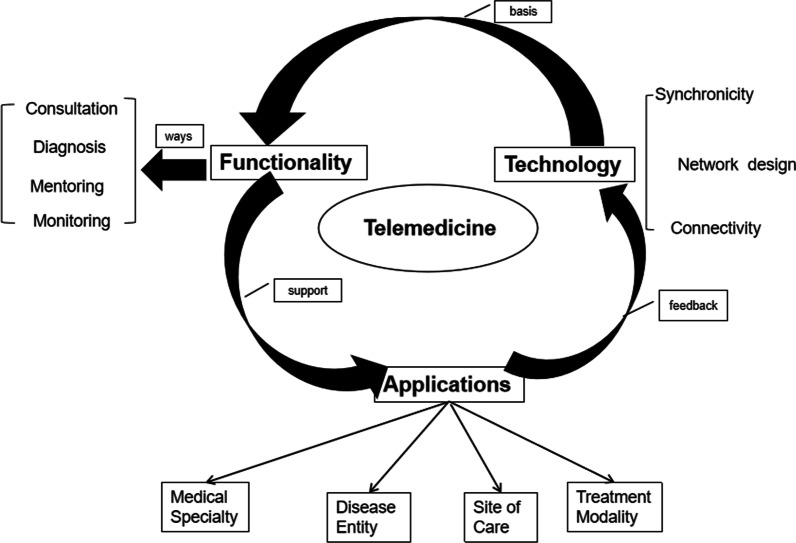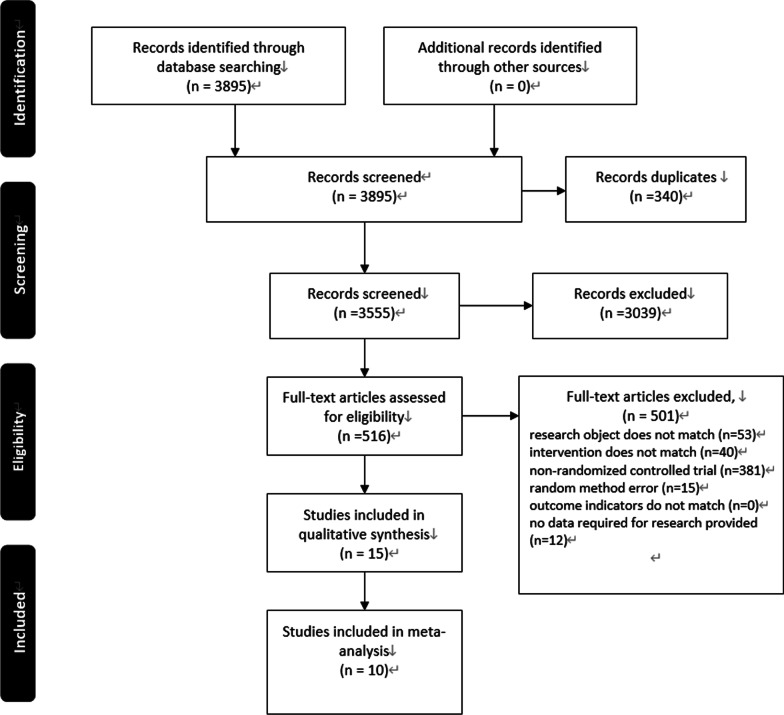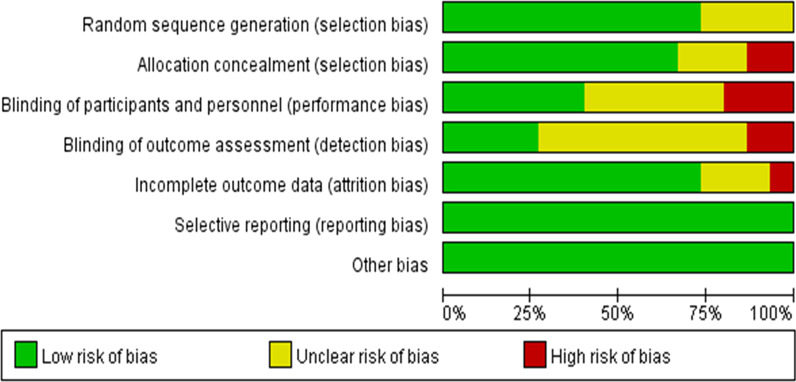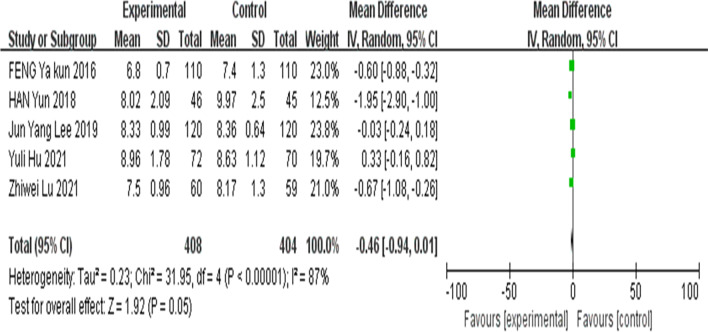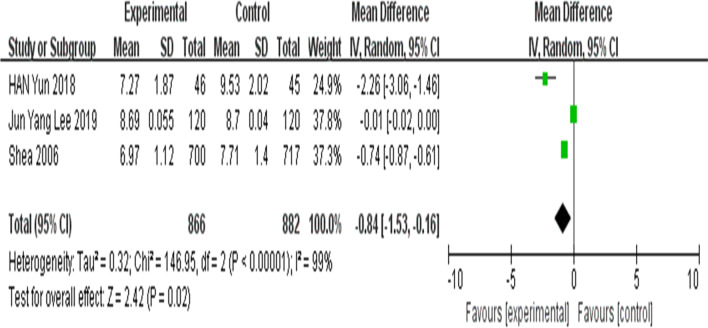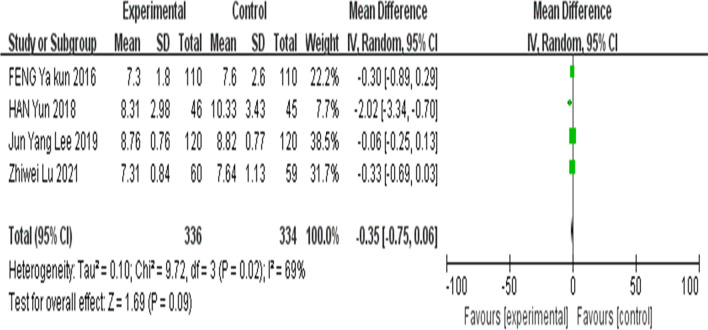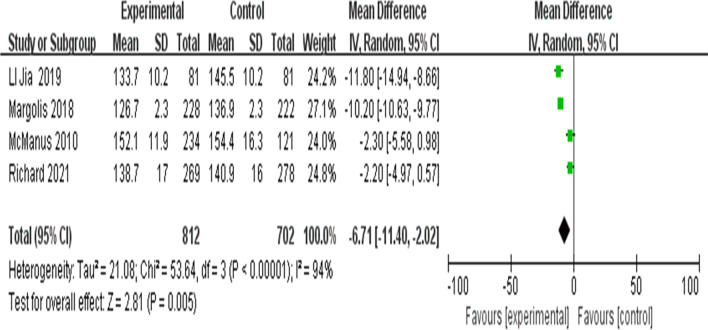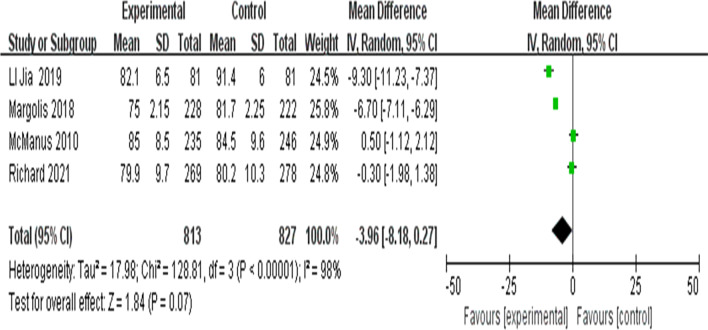Abstract
Background
Telemedicine has been widely used for long-term care and self-management in patients with chronic disease, but there is no consensus regarding the effect of telemedicine on chronic disease management. The aim of this study is to review and analyse the effect of telemedicine on the management of chronic diseases such as hypertension, diabetes, and rheumatoid arthritis using a systematic review and meta-analysis.
Methods
We performed a comprehensive literature search of the Web of Science, PubMed, MEDLINE, EMBASE, CNKI (Chinese database), VIP (Chinese database), WanFang (Chinese database), and SinoMed (Chinese database) databases from their inception until December 31, 2021. The retrieved literature was screened and assessed independently by two authors. We used the risk-of-bias assessment tool recommended by the Cochrane Handbook for Systematic Reviews of Interventions 5.0.2 for assessing literature quality and Revman 5.3 software to conduct the meta-analysis.
Results
Fifteen articles were included in this study. The results of the systematic review indicated that telemedicine consultation and telemonitoring are the most commonly used intervention methods. Telemedicine is helpful for improving self-management in patients with rheumatoid arthritis. The results of the meta-analysis showed patients’ index of glycosylated hemoglobin (HbA1c) improved after 12 months of intervention (MD = − 0.84; 95% CI = − 1.53, − 0.16; Z = 2.42; P = 0.02), and no significant differences in fasting blood glucose (FBG) levels were observed after 6 months of intervention (MD = − 0.35; 95% CI = − 0.75,0.06; Z = 1.69; P = 0.09). The results also showed that systolic blood pressure (MD = − 6.71; 95% CI = − 11.40, − 2.02; Z = 2.81; P = 0.005) was reduced after 6 months of intervention.
Conclusion
Telemedicine had a positive effect on the management of diabetes, hypertension, and rheumatoid arthritis, especially when telemedicine consultation and telemonitoring method were used. When telemedicine was used as a disease management tool for patients with diabetes, the optimal intervention time is 12 months. Telemedicine improved the systolic blood pressure in hypertensive patients while also reducing negative emotions and enhancing medication adherence in rheumatoid arthritis patients.
Keywords: Telemedicine, Diabetes, Hypertension, Rheumatoid arthritis, Systematic review, Meta-analysis
Introduction
During the global COVID-19 pandemic, telemedicine provides a measure for safe social distancing, especially for the long-term care and self-management of patients with chronic disease [1, 2]. Telemedicine is a feasible, credible technology [3], and it has advantages in chronic disease management, such as avoiding the risk of cross-infection between patients. In addition, telemedicine is not limited by time and space requirements. Telemedicine establishes a bridge between healthcare workers and patients for communication and providing medical information [4].
Telemedicine is defined by the American Telemedicine Association (ATA) as an electronic tool to communicate medical information and connect the patients and providers in distant locations [5, 6]. Telemedicine can be composed of the following three segments: technology, functionality, and applications [7, 8]. Technology comprises three elements for transmission and exchange: synchronicity, network design, and connectivity. Synchronicity is incorporated with timing and technology, and it is achieved through video conferencing, telemetry, remote sensing, and other modes of interactive health communication. The functions of network design are to post and share information. Wired and wireless connectivity are always used. The functionality of telemedicine consists of several methods, such as consultation, diagnosis, mentoring, and monitoring. All methods aim to allow the transmission of medical information and realize communication between patients and medical workers. But they still have different, telemedicine consultation is defined as patients consulting the specialist via video or chat which is more interactive and human-centered and can be customized to the individual needs of patients [9, 10], telediagnosis is one of the most developed components of telemedicine[11], it makes use of technology to exchange images and data for making a diagnosis of disease[12] and often does not require direct clinical examinations[13], tele-mentoring is used in medical education to disseminate the knowledge and technology, such as fall prevention and infection control [14, 15], telemonitoring involves remote monitoring using mobile devices or computers to monitor the patients’ vital signs or indicators of disease and is usually used by care providers in different locations[16]. Applications are used as platforms that allow for patients and providers to communicate [7] (Fig. 1).
Fig. 1.
Telemedicine model diagram
Chronic disease is defined as a disease that has one or more of the following characteristics: it is permanent, leaves residual disability, is caused by a nonreversible pathological alteration, requires special training of the patient for rehabilitation, or the patient may be expected to require a long period of supervision, observation, or care [17]. Chronic diseases seriously affect people's lives due to the following: a decline in the quality of life, impaired mobility, negative emotion, and increase in the economic burden, and a higher mortality rate [18]. In 2012, half of all adults in the United States had at least one chronic disease, and at least one in four had two or more [19]. According to the 2015 World Health Organization (WHO) report, chronic diseases account for 38 million deaths per year [20–22] and have become a public health issue [23]. Hypertension, diabetes, and rheumatoid arthritis are common chronic diseases [6, 24–26]. At least one billion people currently have hypertension worldwide, and it is also predicted that 1.56 billion people will have hypertension by 2025 [24]. According to epidemiological survey results, approximately 180 million people worldwide have diabetes, and this number may double by 2030 [25]. The incidence of rheumatoid arthritis in adults worldwide is 0.5%, and it has become one of the top 10 chronic diseases in China. In addition, the incidence of rheumatoid arthritis in adults ranges from 0.5% to 1.0% in the United States [6, 26]. Hence, more attention should be paid to the aforementioned diseases.
A growing number of studies have focused on telemedicine for chronic disease management. However, there is no consensus on the effect of telemedicine on chronic disease management. Therefore, the aim of this study is to review and analyse the effect of telemedicine on the management of hypertension, diabetes, and rheumatoid arthritis using a systematic review and meta-analysis.
Methods
Selection of studies
The inclusion criteria regarding the literature were as follows: (2) the study was a randomized-controlled trial (RCT); (2) telemedicine was the intervention in the study; (3) the disease type must be chronic; and (4) the articles were published in English and Chinese.
Search strategy
The literature search was performed using the Cochrane, CINAHL, EBSCO, Medline, PubMed, EMBASE, Web of Science, JBI, NICE, SinoMed (Chinese database), CNKI (Chinese database), VIP (Chinese database), and WanFang (Chinese database) databases. The article search period interval for each database was from the inception of the database to December 31, 2021.
The English search terms used for literature retrieval included the following: ("Telemedicine" OR "Remote Consultation" OR " telehealth" OR "telemonitoring" OR "Web-based" OR "mobile monitoring" OR "mobile health" OR" mentoring "OR" internet-based" OR "diagnosis "OR"promoting monitoring "OR" mHealth" OR "telecare") AND ("chronic disease" OR "hypertension" OR "rheumatoid arthritis" OR "diabetes” OR “diabetes mellitus") AND (“disease management” OR “management”). Chinese search terms were also used to conduct literature searches of the Chinese databases.
Data extraction
The literature was reviewed by two authors, and a third reviewer was consulted when there was uncertainty regarding eligibility. The two authors screened the literature independently according to the title, keywords, abstract, and full-text reading. The data extracted related to the study characteristics, participants, methods of telemedicine, conclusions, and relevant outcomes.
Risk of bias assessment
The quality of the studies was evaluated using the risk-of-bias assessment tool (RCT recommendation by the Cochrane Handbook for Systematic Reviews of Interventions 5.0.2)[27]. The assessment was independently assessed by two authors. If they had inconsistent opinions after the evaluation, the third author was invited to reassess the quality of the literature.
Data synthesis
The meta-analysis was performed using Revman 5.3 software. We conducted a meta-analysis of three or more articles that reported the same outcome indicators. We calculated a 95% confidence interval (CI), and the meta-analysis test level was set at P = 0.05. I2 statistics were used to assess the heterogeneity of effect size, and the I2 statistic was used to check for inconsistencies between the studies (I2 = 0%–100%; greater than 50% was considered significant statistical heterogeneity). Forest plots were used to visually assess the 95% CIs and P values across studies.
Results
Results of the literature retrieval
Figure 2 shows a flowchart of the literature retrieval process according to the Preferred Reporting Items for Systematic Reviews and Meta-Analyses (PRISMA) statement. The search recovered 3895 articles. We excluded 340 duplicates, and 3039 articles were removed after the title and abstract were assessed. The full texts of 516 articles were read, and articles were excluded if research object did not match, the intervention did not match, the study was not an randomized controlled trial, a random method error was present, the outcome indicators did not match, or if no data required for the study were provided. A total of 15 articles were included in the study.
Fig. 2.
Literature screening flow chart
Risk of bias assessment
The characteristics of the studies are shown in Table 1. Figure 3 shows the results of the quality risk assessment. Eleven studies that achieved the generation of a standard random sequence and proper allocation concealment [28–38], and only two studies did not use the allocation concealment method [37, 39]. Four of them used blinded methods for the participants, investigators, and outcome measurers [28, 33, 36, 40, 41], and two studies clearly mentioned that the participants, investigators, and outcome measurers were not blinded due to the intervention methods used [31, 35, 37]. Most of the literature reported the missing data and the reasons for this. All the literature included in this study was considered high quality after the bias assessment.
Table 1.
Characteristics of included studies
| Author, year | Participants with disease | Telemedicine inventions | Intervention providers | Outcome index | Experiment duration | Conclusion |
|---|---|---|---|---|---|---|
| Han Yun et al. [30] |
(Diabetes) (1) Experiment sample size:46 (2) Control sample size:45 Age:25–75 |
Telemedicine inventions: web-based consultation | Endocrinologist; nurse; nutritionist; exercise therapist; doctor |
HbA1c FBG PBG |
3/6/12 months | FBG was reduced |
| Kun et al. [40] |
(Diabetes) (1) Experiment sample size: 97 Age: 52.6士9.1 (2) Control sample size:89 Age: 54.7土10.3 |
Telemedicine inventions: Telemonitoring |
Nurse Doctor |
HbA1C FBG HDL-C LDL-C |
3/6 months | FBG, HbA1c were improved |
| Lee et al. [28] |
(Diabetes) (1) Experiment sample size:120 Age: 56.1 ± 9.2 (2) Control sample size:120 Age: 70.9 ± 6.8 |
Telemedicine inventions: Telemonitoring |
Doctor Researcher Clinician |
HbA1C FBG BP LDL Total cholesterol |
1/3/6/12 months | SBP and total cholesterol were statistically significant |
| Shea et al. [38] |
(Diabetes) (1) Experiment sample size:700 Age: 70.8 ± 6.5 (2) Control sample size:717 Age: 70.9 ± 6.8 |
Telemedicine inventions: Remote consultation | Nurse case manages; physician |
HbA1c LDL BP |
12 months | HbA1c, BP and LDL were improved |
| Shea et al. [39] |
(Diabetes) (1) Experiment sample size:729 Age: 70.8 ± 6.5 (2) Control sample size:716 Age: 70.9 ± 6.8 |
Telemedicine inventions: remote consultation | Nurse case manages; physician |
HbA1c LDL BP |
12/24/36/48/60 months | HbA1c, BP and LDL levels were improved |
| Sood et al. [31] |
(Diabetes) (1) Experiment sample size:199 Age: 61.6 ± 9.4 (2)Control sample size:83 Age: 61.1 ± 10.0 |
Telemedicine inventions: Remote consultation | A team of a diabetes specialist (endocrinologist) and a nurse practitioner |
HbA1c BP LDL HDL |
18 months | HbA1c was no statistically significant |
| Fountoulakis et al. [26] |
(Diabetes) (1) Experiment sample size:70 Age: 55.2 ± 16.1 (2) Control sample size:35 Age: 55.4 ± 19.2 |
Telemedicine inventions: telemonitoring |
Outpatient Department Endocrinologists Doctor |
HbA1c BMI Cost |
3/6/6 months after discontinuation | Telemonitoring effective in rapidly reducing HbA1c |
| Lu et al. [35] |
(Diabetes) (1) Experiment sample size:60 Age:56.75 ± 12.05 (2) Control sample size:59 Age: 53.17 ± 11.44 |
Telemedicine inventions: Internet-based consultation | pharmacist |
HbA1c FBG edication |
6 months | HbA1c and FBG were no statistically significant |
| Yuli Hu et al. [34] |
(Diabetes) (1) Experiment sample size:72 Age:50.04 ± 5.76 (2) Control sample size:70 Age:52.21 ± 8.38 |
Telemedicine inventions: Internet-based consultation |
Doctors Nurses |
HbA1c Urinary albumin to creatinine ratio Carotid plaque |
The telemedicine system reduced rate of hypoglycemia and indexes of HbA1c | |
| Jia et al. [32] |
(Hypertension) (1) Experiment sample size:81 Age: 70.2 ± 6.5 (2) Control sample size:81 Age: 69.2 ± 6.7 |
Telemedicine inventions: Internet-based consultation |
Nurse Doctor |
BP | 6 months | BP was improved |
| Margolis et al. [37] |
(Hypertension) (1) Experiment sample size:228 Age: 62.0 ± 11.7 (2) Control sample size:222 Age: 60.2 ± 12.2 |
Telemedicine inventions: telemonitoring |
Pharmacists Doctor |
BP | 6/12/18/54 months | BP was decreased after 12 months |
| McManus et al. [33] |
(Hypertension) (1)Experiment sample size:234 Age: 66.6 ± 8.8 (2) Control sample size:246 Age: 66.2 ± 8.8 |
Telemedicine inventions: Telemonitoring | Research team; Family doctor | BP | 6/12 months | BP changed significantly after 6 months and 12 months |
| Richard et al. |
(Hypertension) (1) Experiment sample size:269 Age: 65.2 ± 10.3 (2) Control sample size:278 Age: 66.7 ± 10.2 |
Telemedicine inventions: telemonitoring | Healthcare practitioners | BP | 6/12 months | The systolic blood pressure was improved after one year than usual care |
| Song et al. [29] |
(Rheumatoid arthritis) (1) Experiment sample size: 41 (2) Control sample size: 36 Age: 55.26 ± 10.84 |
Telemedicine inventions: telemonitoring | Nurses |
Medication compliance Disease activity |
3/6 months | The intervention group had significantly higher medication adherence |
| Ferwerda et al. [27] |
(Rheumatoid arthritis) (1) Experiment sample size: 62 (2) Control sample size: 71 Age: 56.35 ± 10.00 |
Telemedicine inventions: internet-based consultation | Therapists |
Beck depression inventory Negative mood Anxiety Satisfaction |
3/6/9/12 months | Patients with psychological distress have reduced |
HbA1c glycosylated hemoglobin; FBG fasting blood glucose; PBG postprandial blood glucose; FPG fasting plasma glucose; HDL-C high-density lipoprotein cholesterol; LDL-C low-density lipoprotein cholesterol; BMI Body Mass Index; BP blood pressure; LDL low density lipoprotein; HbA1c glycosylated hemoglobin; HDL high density lipoprotein; SBP systolic blood pressure; DBP diastolic blood pressure
Fig. 3.
Chart of quality risk assessment of related literature
Systematic review of the effects of telemedicine in patients with hypertension, diabetes, and rheumatoid arthritis
Telemedicine intervention methods
Telemedicine consultation and telemonitoring are the most commonly used telemedicine intervention methods in patients with diabetes, hypertension and rheumatoid arthritis.
A total of nine articles used telemedicine consultation and telemonitoring as telemedicine intervention methods in patients with diabetes [28, 30, 32, 33, 36, 37, 40–42]. Han et al. studied the effect of telemedicine consultation in the disease management of diabetes, and the study showed that patients’ fast blood glucose (FBG) levels were reduced after a 12-month intervention [32]. However, Sood et al. obtained a different result and found that the HbA1c index did not improve after an intervention of 14.8 months using telemedicine consultation. This result was not significant when compared with the control group [33]. In a study by Feng et al., the FBG and HbA1c indexes were improved using telemonitoring as an intervention [42]. Lee et al. evaluated the effects of telemonitoring with team-based management on patients with diabetes, and they reported an improvement in glucose after 24-week and 52-week interventions [30]. Shea et al. used both telemedicine consultation and telemonitoring as interventions for home unit management and nursing case management in patients with diabetes. The results showed that the patients’ HbA1c indexes improved in the experimental group [40, 41]. Fountoulakis et al. also found that telemonitoring that combined a management and feedback system based on transmitted data helped to improve HbA1c indexes [28]. Lu et al. used telemedicine consultation as an intervention which included pharmacy consultation, medication evaluation, and treatment, overall, they found that telemedicine consultation was an effective method for patients with diabetes[37]. Hu et al. also found the telemonitoring of blood glucose levels could reduce the HbA1c index in patients with diabetes[36].
Four articles described the use of telemedicine consultation and telemonitoring as telemedicine interventions in patients with hypertension [34, 35, 38, 39]. In a study conducted by Li et al., out a total of 162 participants were recruited and the experimental group received telemedicine consultation as the intervention method. They found that the patients’ blood pressure improved after 6 months of intervention [34]. Another study investigated the durability of the intervention effect on blood pressure, and they using home blood pressure telemonitoring in the experimental group. The results showed that a change in blood pressure began after 12 months [39]. McManus et al. also used telemonitoring of home blood pressure measurements for the self-management of hypertension. They found that it assisted in reducing blood pressure after 6 and 12 months [35]. However, Richard et al. used telemonitoring intervention for self-management which can provide detailed feedback. The result showed that compared to typical care, the telemonitoring of blood pressure led to better control of systolic blood pressure after one year [38].
Telemedicine consultation as a telemedicine intervention has also been used for patients with rheumatoid arthritis [29, 31]. A study by Ferwerda et al. evaluated the effect of telemedicine consultation on patients with rheumatoid arthritis. The results showed that the telemedicine consultation reduced patients’ anxiety and depression [29]. Song et al. conducted a study to investigate the impact of telemedicine on drug compliance and disease activity in rheumatoid arthritis patients. They found that telemedicine consultation did not improve patient’s symptoms but it did enhance medication compliance [31].
Outcome measures
A total of fifteen articles on the application of telemedicine for disease management were included in the quality evaluation of the literature [28–42]. Six of fifteen articles were related to diabetes, and the outcome indicators included the HbA1c and the FBG indexes. We also compared the effects of telemedicine management after 6 and 12 months of intervention [30, 32, 36, 37, 40, 42]. Four articles described hypertension, and they had the same intervention duratio. Therefore, these ten articles were included in the meta-analysis [30, 32, 34–40, 42]. The remaining five articles were included in a systematic review as follows [28, 29, 31, 33, 41].
Six articles described the use of HbA1c and FBG as the primary outcomes [30, 32, 36, 37, 40, 42]. High FBG is a potential risk factor for small arterial stiffness and it tends to cause diabetic complications [43]. HbA1c, an indirect measure of the mean blood glucose index, reflects the blood glucose level over the previous 2 to 3 months [44]. A meta-analysis of HbA1c was performed according to the 6- and 12-month intervention durations [30, 32, 36, 37, 40, 42].
Another four articles covered disease management for hypertension [34, 35, 38, 39], and telemedicine was the primary intervention method. All of the researchers used systolic blood pressure and diastolic blood pressure as the primary outcomes to reflect blood pressure fluctuations. Hence, we conducted a meta-analysis to test the effect of the intervention.
Results of the meta-analysis
Meta-analysis of the effects of telemedicine in diabetes patients
Six articles used HbA1c and FBG to evaluate the effect of telemedicine on diabetic patients, and we conducted a meta-analysis based on the outcome index and duration of intervention [30, 32, 36, 37, 40, 42].
Meta-analysis of HbA1c after 6 months of intervention
A total of five articles described HbA1c after 6 months of telemedicine intervention. The results showed that the I2 value was 87%, indicating high heterogeneity, thus, we adopted a random-effects model which showed no significant difference in HbA1c indexes between the intervention group and the control group after 6 months of intervention. (MD = − 0.46; 95% CI = − 0.94, 0.01; Z = 1.92; P = 0.05) (Fig. 4).
Fig. 4.
Forest plots of glycosylated hemoglobin after 6 months of intervention between the intervention group and the control group
Meta-analysis of HbA1c after 12 months of intervention
Because of the high statistical heterogeneity (I2 = 99%), the random-effects model was used. The results showed that there were statistically significant differences in HbA1c indexes between the intervention and control groups [30, 32, 40] (MD = − 0.84; 95% CI = − 1.53, − 0.16; Z = 2.42; P = 0.02) (Fig. 5).
Fig. 5.
Forest plots of glycosylated hemoglobin after 12 months of intervention between the intervention group and the control group
Meta-analysis of FBG after 6 months of intervention
This set of data was analysed using a random-effects model due to its high statistical heterogeneity (I2 = 69%). The results showed that there was no significant difference in FBG levels between the experimental group and the control group (MD = − 0.35; 95% CI = − 0.75,0.06; Z = 1.69; P = 0.09) (Fig. 6).
Fig. 6.
Forest plots of fasting blood glucose after 6 months of intervention between the intervention group and the control group
Meta-analysis of the effect of telemedicine in hypertension patients
In this study, we included four articles that investigated the effect of telemedicine on patients with hypertension. Four reported the index of systolic blood pressure and diastolic blood pressure after 6 months of intervention. We conducted the meta-analysis according to the outcome index and duration of intervention [30, 35, 38, 39].
Meta-analysis of the changes in systolic blood pressure
The systolic blood pressures in the experimental and the control groups after 6 months of intervention in the included literature were analysed. A random-effects model was adopted since there was high statistical heterogeneity (I2 = 94%). The results showed that there were statistically significant differences in systolic blood pressure between the group receiving telemedicine and the control group (MD = − 6.71; 95% CI = − 11.40, − 2.02; Z = 2.81; P = 0.005) (Fig. 7).
Fig. 7.
Forest plots of the systolic blood pressure after 6 months of intervention between the intervention group and the control group
Meta-analysis of the changes in the diastolic blood pressure
Four articles described diastolic blood pressure at 6 months of intervention [34, 35, 38, 39]. A random-effects model was used because there was high statistical heterogeneity (I2 = 98%). The results showed that there were no statistically significant differences in diastolic blood pressure between the intervention and control group (MD = − 3.96; 95% CI = − 8.18, 0.27; Z = 1.84; P = 0.07) (Fig. 8).
Fig. 8.
Forest plots of diastolic blood pressure after 6 months of intervention between the intervention group and the control group
Discussion
Telemedicine consultation and telemonitoring are the most commonly used methods of telemedicine intervention
Telemedicine can provide long-term care and treatment for people with chronic diseases via an online application or other telecommunication technology, and this is helpful for maintaining a safe social distance. Telemedicine consultation and telemonitoring are common telemedicine methods. Telemedicine consultations meet the current health care needs of patients while demonstrating convenience. Patients are usually satisfied with the service and have the ability to choose when to conduct consultations [10]. Telemonitoring reduces the number of visits and hospital admissions, thus, scarce medical resources can be used effectively [45]. Many studies have confirmed that telemedicine technologies are beneficial as a medical resource, and telemedicine can also help to adjust care plans in a timely manner [46]. Telemedicine has also been considered a cost-effective method for long-term care [47]. However, there still exist large barriers for patients that have difficulty and experience anxiety when using a computer or mobile phone as a tool to receive telemedicine, especially older individuals [48].
The duration of telemedicine intervention is important for HbA1c index improvement in diabetes patients
HbA1c indexes were significantly improved after 12 months of telemedicine intervention compared with 6 months, and the longer-term intervention had positive effects on the controlling HbA1c indexes. The HbA1c index reflects the average level of blood glucose over a period of time, and this index can change slowly. Hence, a long intervention period may be necessary for improvements to be observed. Thus, the results of the longer intervention period were consistent with other studies that obtained increased HbA1c changes over time [44]. This result was similar to that of Timpel et al., who found that HbA1c began to decrease after up to 12 months of long-term telemedicine intervention [49]. Another study also revealed this phenomenon. A Spanish study of 328 diabetic patients, provided the intervention group with a tele-assistance system that transmitted blood glucose results in real-time and utilized remote consultation. The control group was followed up with regularly at their healthcare centre, notably, one year later, researchers found that the HbA1c indexes were significantly decreased in the intervention group compared with those in the control group [50].
However, the results of this study showed that the change in FBG was not statistically significant after 6 months of telemedicine intervention. Taylor et al. showed that the sensitivity of FBG levels for the diagnosis of diabetes is low, and there are substantial differences between populations[51, 52]. Moreover, FBG needs to be measured after fasting for 8 h or more. Because FBG fluctuates greatly during the day and night, FBG levels measured at the same time point should be compared. Notably, the literature included in this study did not indicate the time that FBG was measured. Therefore, more research is needed to verify the impact of telemedicine intervention on FBG levels.
Systolic blood pressure was improved after telemedicine intervention for 6 months in hypertension patients
There were significant improvements in systolic blood pressure after 6 months of intervention. Although different durations of interventions were reported in patients with hypertension, most patients experienced a significant drop in blood pressure after 6 months of telemonitoring [53–56]. Telemedicine yielded positive effects on the management of hypertension patients, especially after a 6-month intervention. Thus, telemedicine technology could support doctors and nurses in regard to the close, continuous follow-up of hypertension patients.
Telemedicine had positive effects on rheumatoid arthritis patients
Rheumatoid arthritis is one of the most prevalent chronic inflammatory diseases. The primary symptoms of rheumatoid arthritis include rheumatoid nodules, pulmonary involvement or vasculitis, and systemic comorbidities [57]. Patients with rheumatoid arthritis have a long disease duration involving joint deterioration and functional disability, eventually leading to unfavourable disease outcomes. Patients with rheumatoid arthritis often experience psychological distress, such as anxiety and depression, and all of these symptoms seriously affect daily life activities [58]. The method for the long-term management of rheumatoid arthritis patients with telemedicine has developed gradually. Telemedicine as the primary management method among rheumatoid arthritis patients could improve negative emotions and promote medication adherence. More studies should be performed in the future to confirm the effect of telemedicine on the disease management of rheumatoid arthritis.
Conclusion
Here, we conducted a systematic review and analyse to review and analysis the effect of telemedicine on patients with hypertension, diabetes, and rheumatoid arthritis. The results demonstrated that telemedicine consultation and telemonitoring are the primary methods used for telemedicine intervention. This study also indicated that telemedicine had a positive effect on the management of hypertension, diabetes, and rheumatoid arthritis, and that telemedicine was effective in regard to the systolic blood pressure of hypertensive patients after intervention for 6 months. Long-term telemedicine interventions showed a significant effect on HbA1c index management in diabetic patients. Thus, telemedicine has the ability to substantially improve the quality of disease management [59].
The results of this study indicate that telemedicine should be recommended as a useful tool for disease management in patients with chronic diseases such as hypertension and diabetes. Telemedicine could also improve negative emotions and promote medication adherence in rheumatoid arthritis patients. The results indicate that 12 months of telemedicine intervention should be considered for diabetic patients.
Acknowledgements
The authors thank all the participants in the study.
Author contributions
YM assessed the quality evaluation of the literature. She wrote and amended the original manuscript and the revised version of the manuscript; CZ reviewed and amended the original manuscript and mainly amended the revised version of the manuscript; YZ assessed the quality evaluation of the literature; JL and HJ reviewed and revised the original manuscript; YC and YX designed the study and amended the original and revised version of the manuscript. All authors read and approved the final manuscript.
Funding
The work described in this paper was supported in full by a grant from the Fu Xing Nursing Scientific Research Fund of Fudan University, Shanghai, China [Grant Number FNF202063]. The sponsors had no role in the design and conduct of the study in the collection, management, analysis or interpretation of the data in the preparation, review, or approval of the manuscript or in the decision to submit the manuscript for publication.
Availability of data and materials
All data generated or analysed during this study are included in this published article [and its supplementary information files].
Declarations
Ethical approval and consent to participate
Not applicable.
Consent for publication
Not applicable.
Competing interests
The authors declare no competing interests.
Footnotes
Publisher's Note
Springer Nature remains neutral with regard to jurisdictional claims in published maps and institutional affiliations.
Yue Ma and Chongbo Zhao have contributed equally to this work and share first authorship
Contributor Information
Yanpei Cao, Email: yanpeicao@fudan.edu.cn.
Yafang Xu, Email: yafang_xu@fudan.edu.cn.
References
- 1.Cuffaro L, Di Lorenzo F, Bonavita S, Tedeschi G, Leocani L, Lavorgna L. Dementia care and COVID-19 pandemic: a necessary digital revolution. Neurol Sci. 2020;41(8):1977–1979. doi: 10.1007/s10072-020-04512-4. [DOI] [PMC free article] [PubMed] [Google Scholar]
- 2.Smith AC, Thomas E, Snoswell CL, Haydon H, Mehrotra A, Clemensen J, et al. Telehealth for global emergencies: implications for coronavirus disease 2019 (COVID-19) J Telemed Telecare. 2020;26(5):309–313. doi: 10.1177/1357633X20916567. [DOI] [PMC free article] [PubMed] [Google Scholar]
- 3.Sood S, Mbarika V, Jugoo S, Dookhy R, Doarn CR, Prakash N, et al. What Is telemedicine? A collection of 104 peer-reviewed perspectives and theoretical underpinnings. Telemed e-Health. 2007;13(5):573–590. doi: 10.1089/tmj.2006.0073. [DOI] [PubMed] [Google Scholar]
- 4.Craig J, Patterson V. Introduction to the practice of telemedicine. J Telemed Telecare. 2005;11(1):3–9. doi: 10.1177/1357633X0501100102. [DOI] [PubMed] [Google Scholar]
- 5.American Telemedicine Association.Telemedicine glossary[EB/OL]. [2019-08-30]. http://thesource.americantelemed.org/resources/telemedicine-glossary
- 6.Lu Jun ZQ. Application progress of telemedicine technology in home-based rehabilitation of joint function among patients with rheumatoid arthritis. Chin Nurs Res. 2020.
- 7.Bashshur R, Shannon G, Krupinski E, Grigsby J. The taxonomy of telemedicine. Telemed J E Health. 2011;17(6):484–494. doi: 10.1089/tmj.2011.0103. [DOI] [PubMed] [Google Scholar]
- 8.Burke BL, Jr, Hall RW. Telemedicine: pediatric applications. Pediatrics. 2015;136(1):e293–308. doi: 10.1542/peds.2015-1517. [DOI] [PMC free article] [PubMed] [Google Scholar]
- 9.Augusterfer EF, O'Neal CR, Martin SW, Sheikh TL, Mollica RF. The Role of telemental health, tele-consultation, and tele-supervision in post-disaster and low-resource settings. Curr Psychiatry Rep. 2020;22(12):85. doi: 10.1007/s11920-020-01209-5. [DOI] [PMC free article] [PubMed] [Google Scholar]
- 10.Gabrielsson-Järhult F, Kjellström S, Josefsson KA. Telemedicine consultations with physicians in Swedish primary care: a mixed methods study of users' experiences and care patterns. Scand J Prim Health Care. 2021;39(2):204–213. doi: 10.1080/02813432.2021.1913904. [DOI] [PMC free article] [PubMed] [Google Scholar]
- 11.al-Taei MK, Pan Y, Lu DM. An Internet-based telediagnosis system for Chinese medicine. J Telemed Telecare. 2000;6 Suppl 1:S63–5. [DOI] [PubMed]
- 12.Ghai S. Teledentistry during COVID-19 pandemic. Diabetes Metab Syndr. 2020;14(5):933–935. doi: 10.1016/j.dsx.2020.06.029. [DOI] [PMC free article] [PubMed] [Google Scholar]
- 13.Mairinger T. Acceptance of telepathology in daily practice. Anal Cell Pathol. 2000;21(3–4):135–140. doi: 10.1155/2000/601908. [DOI] [PMC free article] [PubMed] [Google Scholar]
- 14.Jaffer U, Vaughan-Huxley E, Standfield N, John NW. Medical mentoring via the evolving world wide web. J Surg Educ. 2013;70(1):121–128. doi: 10.1016/j.jsurg.2012.06.024. [DOI] [PubMed] [Google Scholar]
- 15.Schubert A. Tele-conferencing, distance learning and tele-mentoring: new technology harnessed fro perioperative education. J Educ Perioper Med : JEPM. 2000;2(1):E012. [PMC free article] [PubMed] [Google Scholar]
- 16.Planinc I, Milicic D, Cikes M. Telemonitoring in heart failure management. Card Fail Rev. 2020;6:e06. doi: 10.15420/cfr.2019.12. [DOI] [PMC free article] [PubMed] [Google Scholar]
- 17.Chatfield M. Dictionary of health services management, 2d ed. Health Care Management Review;1983.
- 18.Mohammed MA, Stevens A. The value of administrative databases. BMJ. 2007;334(7602):1014–1015. doi: 10.1136/bmj.39211.453275.80. [DOI] [PMC free article] [PubMed] [Google Scholar]
- 19.Ward BW, Schiller JS, Goodman RA. Multiple chronic conditions among US adults: a 2012 update. Prev Chronic Dis. 2014;11:E62. doi: 10.5888/pcd11.130389. [DOI] [PMC free article] [PubMed] [Google Scholar]
- 20.World Health Organization Noncommunicable diseases. Fact Sheet. [(accessed on 5 April 2016)];2015 Jan; Available online: https://www.who.int/topics/noncommunicable_diseases/factsheets/en/.
- 21.Bauer UE, Briss PA, Goodman RA, Bowman BA. Prevention of chronic disease in the 21st century: elimination of the leading preventable causes of premature death and disability in the USA. Lancet. 2014;384(9937):45–52. doi: 10.1016/S0140-6736(14)60648-6. [DOI] [PubMed] [Google Scholar]
- 22.Pasini E, Corsetti G, Romano C, Aquilani R, Scarabelli T, Chen-Scarabelli C, et al. Management of anaemia of chronic disease: beyond iron-only supplementation. Nutrients. 2021;13(1). [DOI] [PMC free article] [PubMed]
- 23.Yu-di GYYT-tY. Analysis of main risk factors and countermeasures of chronic diseases based on systems archetypes. Chin J Gen Pract;2019.
- 24.Yang T, Zubcevic J. Gut-brain axis in regulation of blood pressure. Front Physiol. 2017;8:845. doi: 10.3389/fphys.2017.00845. [DOI] [PMC free article] [PubMed] [Google Scholar]
- 25.Wild S, Roglic G, Green A, Sicree R, King H. Global prevalence of diabetes: estimates for the year 2000 and projections for 2030. Diabetes Care. 2004;27(5):1047–1053. doi: 10.2337/diacare.27.5.1047. [DOI] [PubMed] [Google Scholar]
- 26.Dr Margaret Chan DOC. Global status report on NCDs 2014. World Health Organization. 2014.
- 27.Higgins, JPT. Cochrane handbook for systematic reviews of interventions version 5.0. 2: Wiley-Blackwell.
- 28.Stelios F, Labrini P, Alexandros G, Athina M, Piaditis G. Impact and duration effect of telemonitoring on HbA1c, BMI and cost in insulin-treated diabetes mellitus patients with inadequate glycemic control A randomized controlled study. Hormones;2015. [DOI] [PubMed]
- 29.Ferwerda M, van Beugen S, van Middendorp H, Spillekom-van Koulil S, Donders ART, Visser H, et al. A tailored-guided internet-based cognitive-behavioral intervention for patients with rheumatoid arthritis as an adjunct to standard rheumatological care. Pain. 2017;158(5):868–878. doi: 10.1097/j.pain.0000000000000845. [DOI] [PubMed] [Google Scholar]
- 30.Lee JY, Chan CKY, Chua SS, Ng CJ, Paraidathathu T, Lee KKC, et al. Telemonitoring and team-based management of glycemic control on people with type 2 diabetes: a cluster-randomized controlled trial. J Gen Intern Med. 2019;35(1):87–94. doi: 10.1007/s11606-019-05316-9. [DOI] [PMC free article] [PubMed] [Google Scholar]
- 31.Song YQ, Reifsnider E, Zhao SP, Xie X, Chen H. A randomized controlled trial of the Effects of a telehealth educational intervention on medication adherence and disease activity in rheumatoid arthritis patients. J Adv Nurs. 2020;76(5):1172–1181. doi: 10.1111/jan.14319. [DOI] [PubMed] [Google Scholar]
- 32.Han Yun XY, Xillhlla YE, Xiaona LI, Yang P, Wu Y, Chen L, Wu H. Application of chronic disease management model with Internet plus in patients with type 2 diabetes mellitus. Chin J Nurs;2018.
- 33.Sood A, Watts SA, Johnson JK, Hirth S, Aron DC. Telemedicine consultation for patients with diabetes mellitus: a cluster randomised controlled trial. J Telemed Telecare. 2018;24(6):385–391. doi: 10.1177/1357633X17704346. [DOI] [PubMed] [Google Scholar]
- 34.Jia L. Application of chronic disease management model of hospital community integration based on”internet+"for elderly patients with hypertension. Chin Nurs Res;2019.
- 35.McManus R, Mant J, Bray EP, Holder R, Jones MI, Greenfield S, et al. Telemonitoring and self-management in the control of hypertension (TASMINH2): a randomised controlled trial. Lancet. 2010;376(9736):163–172. doi: 10.1016/S0140-6736(10)60964-6. [DOI] [PubMed] [Google Scholar]
- 36.Hu Y, Wen X, Ni L, Wang F, Hu S, Countries FFJIJoDiD. Effects of telemedicine intervention on the management of diabetic complications in type 2 diabetes. 2021;41(2):322–8.
- 37.Lu Z, Li Y, He Y, Zhai Y, Wu J, Wang J, et al. Internet-based medication management services improve glycated hemoglobin levels in patients with type 2 diabetes. Telemed J E Health. 2021;27(6):686–693. doi: 10.1089/tmj.2020.0123. [DOI] [PubMed] [Google Scholar]
- 38.McManus RJ, Little P, Stuart B, Morton K, Raftery J, Kelly J, et al. Home and Online Management and Evaluation of Blood Pressure (HOME BP) using a digital intervention in poorly controlled hypertension: randomised controlled trial. BMJ. 2021;372:m4858. doi: 10.1136/bmj.m4858. [DOI] [PMC free article] [PubMed] [Google Scholar]
- 39.Margolis KL, Asche SE, Dehmer SP, Bergdall AR, Green BB, Sperl-Hillen JM, et al. Long-term outcomes of the effects of home blood pressure telemonitoring and pharmacist management on blood pressure among adults with uncontrolled hypertension. JAMA Netw Open 2018;1(5). [DOI] [PMC free article] [PubMed]
- 40.Shea S, Weinstock RS, Starren J, Teresi J, Plamas W, Field L, et al. A randomized trial comparing telemedicine case management with usual care in older, ethnically diverse, medically underserved patients with diabetes mellitus. J Am Med Inform Assoc. 2006;13(1):40–51. doi: 10.1197/jamia.M1917. [DOI] [PMC free article] [PubMed] [Google Scholar]
- 41.Shea S, Weinstock RS, Teresi JA, Palmas W, Starren J, Cimino JJ, et al. A randomized trial comparing telemedicine case management with usual care in older, ethnically diverse, medically underserved patients with diabetes mellitus: 5 year results of the IDEATel Study. J Am Med Inf Assoc. 2009;16(4):446–456. doi: 10.1197/jamia.M3157. [DOI] [PMC free article] [PubMed] [Google Scholar]
- 42.Ya-kun F, Xiao-kun LY-jG. The application of telemedicine in the integrated management of type 2 diabetes mellitus. Chin J Diabetes. 2016.
- 43.Zheng M, Zhang X, Chen S, Song Y, Zhao Q, Gao X, et al. Arterial stiffness preceding diabetes. Circ Res. 2020;127(12):1491–1498. doi: 10.1161/CIRCRESAHA.120.317950. [DOI] [PubMed] [Google Scholar]
- 44.Nomura K, Inoue K, Akimoto K. A two-step screening, measurement of HbA1c in association with FPG, may be useful in predicting diabetes. PLoS ONE. 2012;7(4):e36309. doi: 10.1371/journal.pone.0036309. [DOI] [PMC free article] [PubMed] [Google Scholar]
- 45.Silven AV, Petrus AHJ, Villalobos-Quesada M, Dirikgil E, Oerlemans CR, Landstra CP, et al. Telemonitoring for patients with COVID-19: recommendations for design and implementation. J Med Internet Res. 2020;22(9):e20953. doi: 10.2196/20953. [DOI] [PMC free article] [PubMed] [Google Scholar]
- 46.Lamothe L, Fortin JP, Labbé F, Gagnon MP, Messikh D. Impacts of telehomecare on patients, providers, and organizations. Telemed J E Health. 2006;12(3):363–369. doi: 10.1089/tmj.2006.12.363. [DOI] [PubMed] [Google Scholar]
- 47.Gaikwad R, Warren J. The role of home-based information and communications technology interventions in chronic disease management: a systematic literature review. Health Inf J. 2009;15(2):122–146. doi: 10.1177/1460458209102973. [DOI] [PubMed] [Google Scholar]
- 48.Lamothe L, Fortin J-P, Labbé F, Gagnon M-P, Messikh D. Impacts of telehomecare on patients, providers, and organizations. Telemed J e-health. 2006;12:363–369. doi: 10.1089/tmj.2006.12.363. [DOI] [PubMed] [Google Scholar]
- 49.Timpel P, Oswald S, Schwarz PEH, Harst L. Mapping the evidence on the effectiveness of telemedicine interventions in diabetes, dyslipidemia, and hypertension: an umbrella review of systematic reviews and meta-analyses. J Med Internet Res. 2020;22(3). [DOI] [PMC free article] [PubMed]
- 50.Rodríguez-Idígoras MI, Sepúlveda-Muñoz J, Sánchez-Garrido-Escudero R, Martínez-González JL, Escolar-Castelló JL, Paniagua-Gómez IM, et al. Telemedicine influence on the follow-up of type 2 diabetes patients. Diabetes Technol Ther. 2009;11(7):431–437. doi: 10.1089/dia.2008.0114. [DOI] [PubMed] [Google Scholar]
- 51.Rayburn WF. Diagnosis and classification of diabetes mellitus: highlights from the American Diabetes Association. J Reprod Med. 1997;42(9):585–586. [PubMed] [Google Scholar]
- 52.Taylor R, Zimmet P. Limitation of fasting plasma glucose for the diagnosis of diabetes mellitus. Diabetes Care. 1981;4(5):556–558. doi: 10.2337/diacare.4.5.556. [DOI] [PubMed] [Google Scholar]
- 53.Paré G, Moqadem K, Pineau G, St-Hilaire C. Clinical effects of home telemonitoring in the context of diabetes, asthma, heart failure and hypertension: a systematic review. J Med Internet Res. 2010;12(2):e21. doi: 10.2196/jmir.1357. [DOI] [PMC free article] [PubMed] [Google Scholar]
- 54.Ferrari R. The role of telemedicine in hypertension management: focus on blood pressure telemonitoring. Curr Hypertens Rep. 2015;17:535. doi: 10.1007/s11906-015-0535-3. [DOI] [PubMed] [Google Scholar]
- 55.Rogers M, Buchan D, Small D, Stewart C, Krenzer B. Telemedicine improves diagnosis of essential hypertension compared with usual care. J Telemed Telecare. 2002;8:344–349. doi: 10.1258/135763302320939239. [DOI] [PubMed] [Google Scholar]
- 56.Omboni S, Ferrari R. The role of telemedicine in hypertension management: focus on blood pressure telemonitoring. Curr Hypertens Rep 2015;17(4). [DOI] [PubMed]
- 57.Smolen JS, Aletaha D, McInnes IB. Rheumatoid arthritis. Lancet. 2016;388(10055):2023–2038. doi: 10.1016/S0140-6736(16)30173-8. [DOI] [PubMed] [Google Scholar]
- 58.Malm K, Bremander A, Arvidsson B, Andersson ML, Bergman S, Larsson I. The influence of lifestyle habits on quality of life in patients with established rheumatoid arthritis-A constant balancing between ideality and reality. Int J Qual Stud Health Well-being. 2016;11:30534. doi: 10.3402/qhw.v11.30534. [DOI] [PMC free article] [PubMed] [Google Scholar]
- 59.McLean S, Sheikh A, Cresswell K, Nurmatov U, Mukherjee M, Hemmi A, et al. The impact of telehealthcare on the quality and safety of care: a systematic overview. PLoS ONE. 2013;8:e71238. doi: 10.1371/journal.pone.0071238. [DOI] [PMC free article] [PubMed] [Google Scholar]
Associated Data
This section collects any data citations, data availability statements, or supplementary materials included in this article.
Data Availability Statement
All data generated or analysed during this study are included in this published article [and its supplementary information files].



